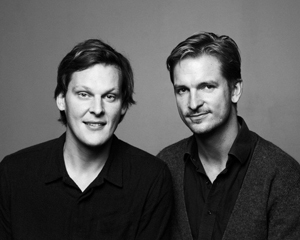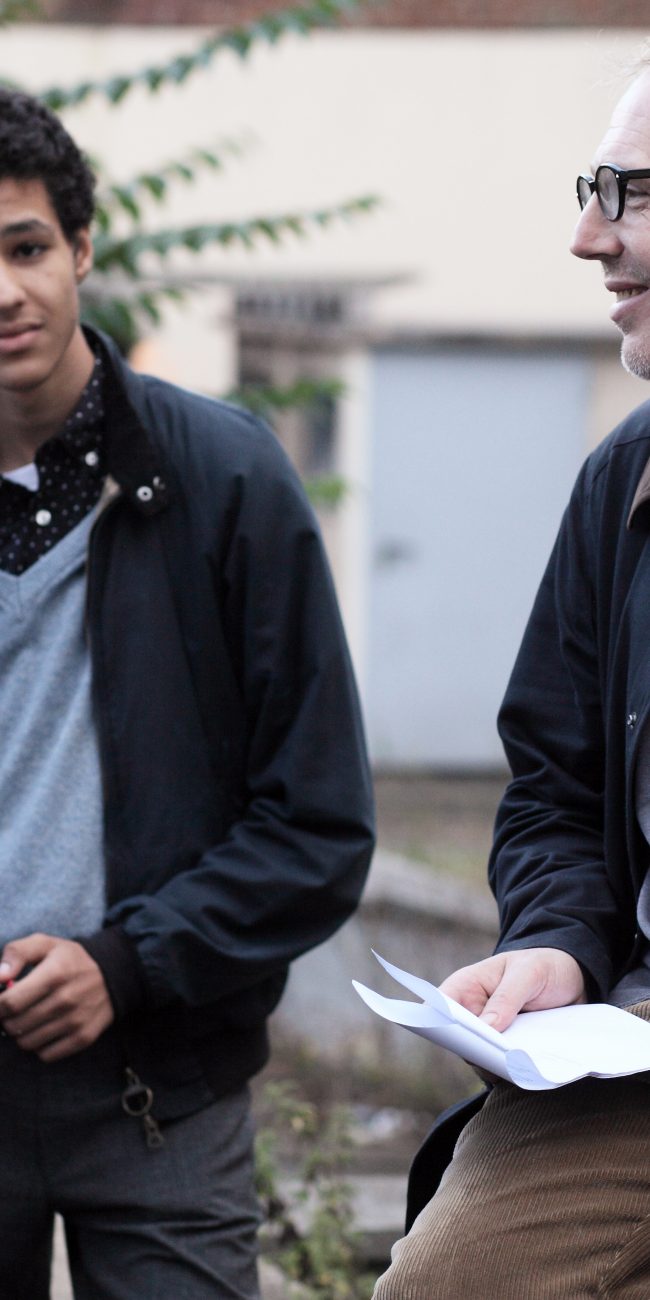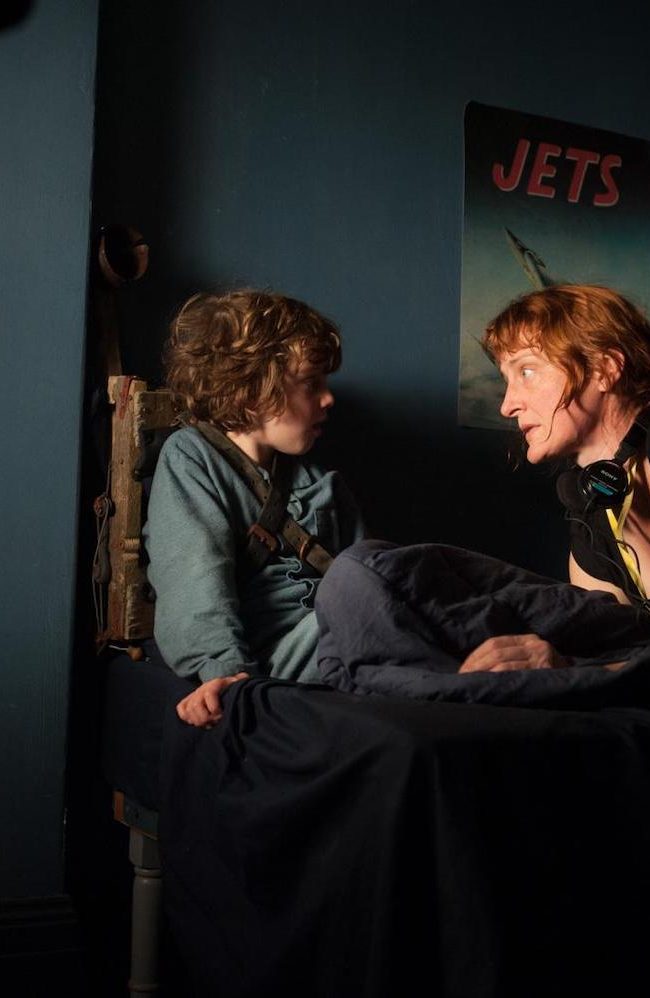A Conversation with Andreas Koefoed and Christian Bonke (BALLROOM DANCER)
Day three of the 2012 Tribeca Film Festival: it’s sunny outside but we’re in the clubby, windowless Cadillac Press Lounge. There’s complimentary coffee and ice cream; plates of turkey wraps and sushi are laid out on no fixed schedule; the mix on the sound system is Björk, Portishead and such. A brand-new Escalade stares out at the proceedings.
Danish filmmakers Andreas Koefoed and Christian Bonke are friendly and engaging and completely on point. Ballroom Dancer is their first feature and it’s getting outstanding reviews (read the full HTN review); they’re in the forefront of modern, character-and-story-driven documentary filmmaking. The film follows the tortured, charismatic former Latin dance champion Slavik Kryklyvyy as he attempts to recapture his crown with his new lover Anna Melnikova.
Bonke and Koefoed are very much a team, with a remarkable clarity about every aspect of their film and the process of making it. In their responses they trade off effortlessly, like basketball players making blind passes.
Hammer To Nail: The first thing I wanted to ask you is how did you come across Slavik?
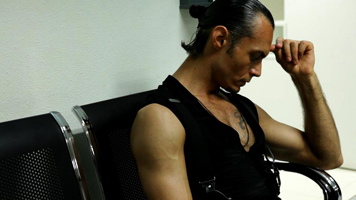 Andreas Koefoed: Our producer Jakob has a wife who’s a former top dancer and she’s good friends with Slavik.
Andreas Koefoed: Our producer Jakob has a wife who’s a former top dancer and she’s good friends with Slavik.
Christian Bonke: And she used to compete with him actually. That environment is quite secluded but she kind of introduced us to different couples and we were filming several couples before Slavik. We heard about him—he was kind of a legend, and people said, “You should meet him,” but he was quite hard to get a hold of. Then finally we met him and we were like “Okay, this is our protagonist, let’s get rid of all the other couples,” because he reeks of drama, you know? So we knew quite fast that he would be the one. But we were also filming the leading couple in the world, Michael and Joanna, who’s also in the film, the blond…
H2N: Right, Joanna, who never speaks—you just see her winning.
CB: But they were not as interesting; they were too harmonious, they never fight…
AK: They always become number one, so there’s no problems, and Slavik was making this comeback so it was perfect timing to follow him.
H2N: This film achieves such a—it almost has the arc of a novel or a narrative film. Was that just luck, or do you have a specific approach to documentary that helps that?
AK: I think both of us work with this style or method where we try to create scenes by being present and observational but then…
CB: Not using interviews.
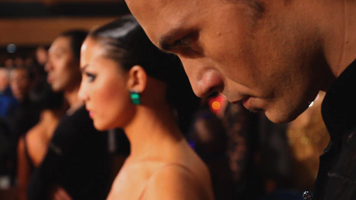 AK: …just capturing the important moments as beautifully as possible. But both of us are inspired by fiction films as well, so of course that comes into it. We want to make it seductive, and to go into the heads of the characters, and not to make interviews and ask questions and all that. So that’s a particular style that we both work with but it’s also a style that has been developed in Denmark over the last 5-10 years.
AK: …just capturing the important moments as beautifully as possible. But both of us are inspired by fiction films as well, so of course that comes into it. We want to make it seductive, and to go into the heads of the characters, and not to make interviews and ask questions and all that. So that’s a particular style that we both work with but it’s also a style that has been developed in Denmark over the last 5-10 years.
CB: But we really wanted to make a seductive film, and that fictionalized way of telling the story, the narrative, also seduces people I think, because you don’t really stop, you don’t have these interviews, and we just really wanted to make a very seductive documentary. Documentaries are not usually, like, trying to seduce people. And also, we wrote a script quite early in the process where we imagined what can happen here.
AK: And the best-case scenario of what would happen in the story, but actually the reality is it turns out to be sometimes even more strong.
CB: And then we re-wrote the script along the way. When something different happened we could take scenes out and put the reality in and then, “Okay, what’s gonna happen next?” So we didn’t actually film that much, because we had the script to be quite precise about what to film, so I think we only had like 70 hours of material, which is quite little.
H2N: There’s been a trend in documentary filmmaking where people are actually staging scenes, or creating scenes that sort of reflect what happens in the real story and I wonder how you feel about that and if you used any of that yourselves.
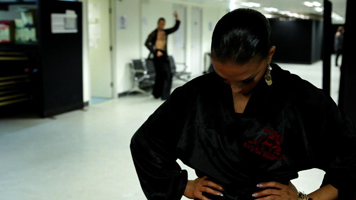 AK: I’m very open towards that; I think in some situations it can work to ask people, “Can you sit on this couch and talk about this?” And then you pretend that it just happened like that. I think it’s all about being truthful to the characters and to the story. In our film we didn’t stage really because our main characters were so focused on their dancing so they actually didn’t want us to interfere too much, but they themselves—they staged themselves, you could say, by interacting and having arguments in front of the camera, so we didn’t need to do that much. We were ready to do it but it just didn’t need it and it didn’t work like that.
AK: I’m very open towards that; I think in some situations it can work to ask people, “Can you sit on this couch and talk about this?” And then you pretend that it just happened like that. I think it’s all about being truthful to the characters and to the story. In our film we didn’t stage really because our main characters were so focused on their dancing so they actually didn’t want us to interfere too much, but they themselves—they staged themselves, you could say, by interacting and having arguments in front of the camera, so we didn’t need to do that much. We were ready to do it but it just didn’t need it and it didn’t work like that.
CB: But I think we both feel that film has to work, it has to seduce people in a way, more than that old-fashioned way to regard documentary as “this is the truth!” The way that the story has some truth in it—I don’t really think we regard documentary and fiction very separately like that.
AK: But we didn’t stage.
CB: No, no, we didn’t, but we could have easily done it, we thought a lot about doing it actually.
AK: But it just never happened and we didn’t make it.
CB: They were so obsessed and dedicated to their professional lives, so a lot of times we just we could feel that we couldn’t interrupt them like that.
AK: And they said, “You can be here in our room just before the competition, but just stay quiet, we have to focus.” That was the message.
CB: And that was also very lucky for us, because they were so dedicated, so after not too long they kind of didn’t mind us being there, so they really just reacted as they would.
AK: And the access we had to them was really really good, so I think that made the whole thing work. Access is everything.
CB: They were so generous to share their lives with us, so we really owe them so much for this film. Slavik in particular of course.
H2N: Why do you think Slavik was willing to show so much? I mean, especially the climactic scene, it’s so intense and personal and just like a devastating moment in his life, clearly. Why do you think he was willing to share that?
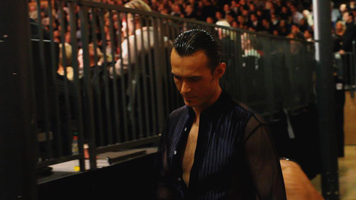 AK: I think from the beginning he wanted to be in the film because he is a living legend within the dance world and to have a film about yourself, that just adds to that position, and he was making a comeback and he thought he would be number one again and then having a film, that would be perfect. But then it turned out differently and then when it got critical between them I think he opened up much more than before and he let us into that, I think, because he also wanted to share it, and he told us that he had decided that he wanted to let us into his emotional life and to the crisis because it might be interesting for people to watch it and to relate to it and to feel it. So he is a performer and he shows his emotions and he did that by showing himself.
AK: I think from the beginning he wanted to be in the film because he is a living legend within the dance world and to have a film about yourself, that just adds to that position, and he was making a comeback and he thought he would be number one again and then having a film, that would be perfect. But then it turned out differently and then when it got critical between them I think he opened up much more than before and he let us into that, I think, because he also wanted to share it, and he told us that he had decided that he wanted to let us into his emotional life and to the crisis because it might be interesting for people to watch it and to relate to it and to feel it. So he is a performer and he shows his emotions and he did that by showing himself.
CB: But also I think that for us Westerners we have a different take on, like, feelings and sorrow than Russians do. I think a Russian protagonist is really good in a documentary because they view life as—there has to be sorrow, there has to be pain, it’s part of the whole thing. Where we’re more superficial and pretend that “oh, everything’s good.” But he really, I don’t think he’s so ashamed of that kind of feelings as we would be. It’s also a cultural thing.
AK: And he’s so much an artist. His private life blends together with his dance, so I think in that sense you can’t separate it and he would never say, “I’m just a dancer, don’t get too close.” I think he was just being there—all in one person would be the art and the personal life.
CB: I can just add to that we don’t speak Russian at all, so a lot of times we didn’t quite know what they were talking about. We could just point the camera; we had a notion about the energy in the room, but that also created a kind of a mental bubble for them, because they knew that we didn’t understand, so they could kind of feel they had some private life even though we were there.
H2N: What did you think about that scene in the car where he talks about moving to Florida, and cleaning hotels? It was a very interesting scene but it seemed so out of…
CB: We’ve been discussing that quite a lot; you [Andreas] have been quite crazy about it and I was a little more reluctant, but we thought that you could feel that what he’s saying there, he’s talking about this imaginary life they could live, but it shows that he’s a little bit fed up with the competition—he’s in that world even though he has other dreams, and he’s tired from it, I think, and that’s his whole problem, that he’s caught up in a reality of competition and dancing because he’s never tried anything else, so he didn’t know what to do. I think he lost his energy and his… joy for dancing, actually. He lost it but he didn’t know what else to do.
AK: So that scene shows a possible escape route for him, and also it was nice to have it because he’s also making a joke about it, and in the film he doesn’t really joke but he is actually a quite funny guy, and I think it’s nice to have something else than just a very serious very ambitious guy. You get a little glimpse of also what Anna could be in love with—a guy who’s joking and wants to take her to different places.
H2N: And what about Anna? It seemed like the footage of her with the new boyfriend and then getting married—did she have qualms about that, and for Slavik to see that?
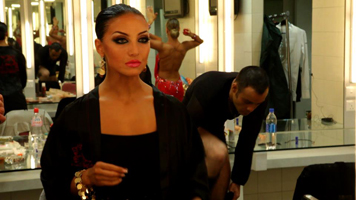 CB: They are not on good terms, Slavik and Anna, they don’t talk at all. She actually invited us to their wedding and asked us to film everything, so she didn’t care about that at all actually. She really likes the film, but her husband is not crazy about it because now he’s a little bit the guy who’s dancing with Slavik Kryklyvyy’s former dance partner, he’s a little bit in the shadow of him.
CB: They are not on good terms, Slavik and Anna, they don’t talk at all. She actually invited us to their wedding and asked us to film everything, so she didn’t care about that at all actually. She really likes the film, but her husband is not crazy about it because now he’s a little bit the guy who’s dancing with Slavik Kryklyvyy’s former dance partner, he’s a little bit in the shadow of him.
AK: He’s fed up with Slavik.
CB: He doesn’t want to hear any more about Slavik.
AK: I think it was important to Anna to show that she moved on, because in the first part of the film she’s not—you can feel that she’s not really well.
CB: She’s a little girl who’s really looking up to this legend; she’s been watching him on television her whole life, and suddenly she’s dancing with him and she’s a little star-struck, and she develops greatly throughout the film; in the beginning she’s a little chubby Russian girl and in the end she’s like a strong woman. We talked a lot about how much should she should be in the film because her development is quite crazy actually. She develops a lot as a character—maybe in some ways even more than Slavik.
AK: I think it was important for her to show that she was now independent and she took her own choice by leaving Slavik and finding a new husband, so I think that’s why she let us film the wedding and all that, because it made her show her power and independence.
H2N: Were there scenes that were too personal, or was there anything that you couldn’t really use in the film although you would’ve liked to?
AK: Not so much; I think we kind of had just enough to tell the story. I think it was not like—I don’t think we have something that is too personal.
CB: Actually there was one point that we filmed during the last scene in which they were dancing and she actually broke down and really cried and then they went into a room and had to have a private talk, and that was the only time actually. They asked us to turn off the cameras.
AK: But then the final scene in the film came just afterwards. And we had a lot of good scenes in Hong Kong; we had to leave quite [a few] scenes out. We could’ve made a film just in Hong Kong, because it was so intense. They had to dance three big shows, and they had split up and on every break Anna would go out and find her new boyfriend, and Slavik would be depressed and crying and it was very intense. But in the film, because the journey’s so long, you can’t have it all at the end, it became too heavy, so we just had to get the best scenes.
CB: That was really hard to let go of, because we have a lot of hours where you can just feel that gap between them even though they’re in the same room and they have to go dance together. So we’re actually editing like a small sequence on Facebook just before we release the DVD, where you can see that material, because we think we really have to use it somehow.
AK: So it will be like a small story just from Hong Kong and the situation there.
H2N: How did you conceptualize working in the actual dance sequences, like telling a story through the actual dancing, or how that related to the story?
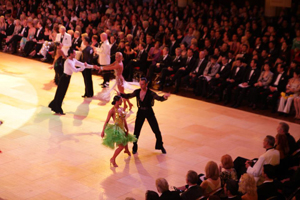 CB: From the beginning we thought that was actually why we went into this branch of this business, that we thought it was interesting that the couples on the floor dance together expressing a love story and we thought, okay, there must be quite a big contrast to their private lives, to the fairytale story they’re telling on the dance floor. So we really wanted to look at that contrast, and we all know the very glossy and glamorous, romantic shows on television, Strictly Come Dancing and all that, so of course it was our ambition to see what that was really like.
CB: From the beginning we thought that was actually why we went into this branch of this business, that we thought it was interesting that the couples on the floor dance together expressing a love story and we thought, okay, there must be quite a big contrast to their private lives, to the fairytale story they’re telling on the dance floor. So we really wanted to look at that contrast, and we all know the very glossy and glamorous, romantic shows on television, Strictly Come Dancing and all that, so of course it was our ambition to see what that was really like.
AK: In some cases the dancers would really reflect their personal life as well. I mean they even dance to “Always On My Mind,” and all the lyrics—it almost fits too well.
CB: It’s too much in a way, and if it was fiction nobody would ever do that, it’s too cheesy.
AK: They put it on themselves, so it was maybe like a comment on their own situation, or for him to show his emotions to her because he couldn’t express it in words, but then in those cases it was nice to have the dance as a reflection, a representation of their private life. But actually we had some ideas about making, like, even more fantastic dance sequences, filmed with a lot of cranes and everything, but we never made it and I think it works as it is now, but we could’ve…
CB: But of course dancing wasn’t really what we were interested in, and people know what that looks like, so we never felt there should be a lot of dancing in the film; it turned out in the end there was probably a little more dance than we had expected.
H2N: We see them interacting with their coaches and advisers, but were there other characters who were influencing both Slavik and Anna’s decisions and their behavior toward each other?
CB: Slavik has a psychologist; we never met her actually, and I think Anna is very close to her mother and you see her very briefly in the film but they talk every day, I think, so they might have influenced them as well.
H2N: There’s a sort of gap between when they break up and when you end up in Hong Kong; were you still following them, or did you step back for a while?
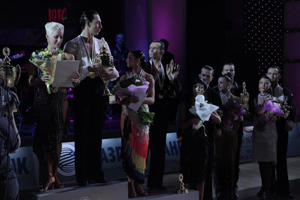 AK: We followed them for about a year when we went with them to competitions and rehearsing and all that and not much was happening; they were doing pretty good in some competitions, and then suddenly we heard, “Oh now there’s a crisis: she might’ve met a new boy,” and we were thinking, “Oh, we’re just sitting here in Copenhagen, we’re gonna miss the whole story,” and then luckily we got in contact with them and we met Slavik in Germany.
AK: We followed them for about a year when we went with them to competitions and rehearsing and all that and not much was happening; they were doing pretty good in some competitions, and then suddenly we heard, “Oh now there’s a crisis: she might’ve met a new boy,” and we were thinking, “Oh, we’re just sitting here in Copenhagen, we’re gonna miss the whole story,” and then luckily we got in contact with them and we met Slavik in Germany.
CB: We tried for a while and he didn’t respond and then suddenly he called us and he said, “I need you guys—I need to share this story with somebody.”
AK: And then we met Anna in London and then within two weeks we shot the second part of the film, because everything was happening so fast, so that was a crucial moment in the process of making the film.
CB: But it also tells about how a dancer’s life is because he didn’t really have anybody else to share his story with, because a professional dancer’s in a new location every third day, so it’s hard to have any social life. So in a way I think the film got to be a place where he could express himself also, so he was the director of the film in some way.
H2N: What about the scene on the yacht where we first see Anna with her new boyfriend—I love the way you put it together, because we don’t know what’s going on and then you kind of see like an energy between them. Was that just one shot of many that really worked?
CB: We have just a fantastic editor, Asa Mossberg, who’s also the editor for Lars von Trier, and she made that and we really, it was just—we were out of the editing room I think and we came back and she had put it together and we never touched it again. It was just perfect. And the music, that’s the only place in the whole film where it’s not a classical score, it’s a Danish band called “Efterklang;” also that’s the first time you get out of the dancing environment, you get out and you see something else, there’s blue sky and water, and people are enjoying themselves, so we wanted to show that as well, that she kind of got a hold of something outside of that world she had with Slavik.
AK: It was the freedom that she kind of tasted in that scene.
CB: And that seduced her, that whole taste of freedom.
H2N: So you mentioned that there’s a whole kind of a movement in Denmark with the way documentaries are being made?
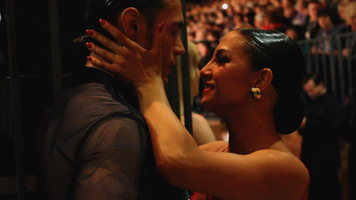 AK: I think in Denmark we’re lucky that the film industry is quite small and there’s one film school, so all the best cinematographers and editors and documentary directors know each other and they use each other, so I think that’s different from many other countries where it’s more divided between television and documentary, and then feature films on the other side, so we are able to use some of the best craftsmen and to also borrow some methods, some ideas from fiction films, so it blends pretty well together.
AK: I think in Denmark we’re lucky that the film industry is quite small and there’s one film school, so all the best cinematographers and editors and documentary directors know each other and they use each other, so I think that’s different from many other countries where it’s more divided between television and documentary, and then feature films on the other side, so we are able to use some of the best craftsmen and to also borrow some methods, some ideas from fiction films, so it blends pretty well together.
CB: But that whole development I think started in the film school where you are taught not to use interviews, and then lately actually there’s been a mix between documentary and fiction, so that also affects the fiction. There are more and more films being made where maybe you have an actor as the protagonist but everybody else is actually playing themselves. There is a film that is happening in a prison where everybody is former inmates or former policemen and there’s only one actor. So it all affects each other actually. But there’s a lot of documentaries that are turning more fictionalized these days.
AK: It’s also a matter of the equipment, because now with a small camera you can shoot something that looks very good, and you couldn’t do that 5-10 years ago in the same sense, so I think that will keep going on and move even further towards the hybrid.
CB: I think we’re both quite fond of that direction and I have an urge to go that way, to explore that even more.
H2N: In America we’re very familiar with Dogme 95, but is film theory actually evolving in Denmark?
CB: Actually I think the filmmakers themselves are not that much into theory but the whole film institute is really strong there and there’s a lot of intellectuals around the film industry who try to define it. In that sense, I do think that there is a movement and a language about it.
H2N: And does that affect you at all?
AK: We went to the same film school and most Danish directors went to that school. We had the same teacher and he has certain ideas about how a documentary should be, but first and foremost it’s about finding your own language, so each student spends four years just finding his own language, doing experiments, and I think that’s where it comes from, so it’s not like everybody has to work in the same direction, make the same style, adapt to that; it comes also from the inside, what do you want to tell, what kind of stories are important for you, what kind of characters do you connect to? So in that sense it becomes more personal and more autobiographical as well, and I think you can feel that in the films.
CB: Our teacher is Arne Bro and the way he teaches is a lot about using what somebody could call a fault or an error, what you do, but he says that is your language, so it’s actually not about doing anything correct, it’s about using your own material. And he really [inspired] so many people in the documentary business.
H2N: That kind of connects to Lars von Trier’s ideas too.
AK: Yeah, he loves the mistakes. He doesn’t want the perfection. He wants all the little weird things. That’s what makes it alive in a sense.
CB: He went to the same school as well, but on a fiction line.
H2N: So are you going to continue working together?
CB: Not right now, but if the right project [came along], I would be open to it. I don’t know about Andreas! [CB laughs]
AK: I’m open as well! [AK laughs] There are a lot of advantages in the process of making a film if you work together and it works. In this case it went really well; we both shot the film, I guess like 50-50, we swapped the camera; we had each other to discuss with. I think it can be a lonely process to make a film, especially if it goes on for 2-3 years. And this process was not lonely at all, so I think that’s really nice, but of course the project has to suit the constellation and the other way around, so right now there’s no plan, but there could come a new plan.
CB: We played a lot of ping-pong together during the whole process; you could see that as a cooperation as well.
H2N: What are your plans individually?
CB: Right now I’m working on a smaller film about the cultural minister of Denmark who’s openly gay and very innovative and tries to change the political system, and it’s gonna be interesting if he can actually do that or if he will fail, and I’m trying to do a film in Cuba about a boxer but I’m only in the beginning—I seriously need funding before I can take it from here.
AK: I’m making a film about a Danish guy who back in 1995 dropped four tons of weapons over India and fled back to Denmark and hid there, and India still wants him extradited for a trial, but the Danish high court decided that he couldn’t be sent, so I followed him for one-and-a-half years. And then I have another film about two African boys from Senegal who play soccer who try to go to Europe; they are discovered by an agent and they go to Chelsea for a try-out, to make it, to play, to get out of poverty through soccer. It’s a classic story. There’s a lot of African young guys who try that and 99% fail and they are left in the streets of Europe. I’ve been working on that for some years now. I have to shoot some more.
—Paul Sbrizzi







